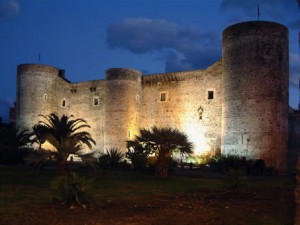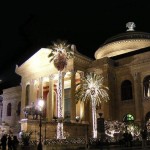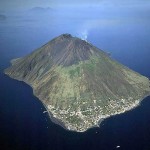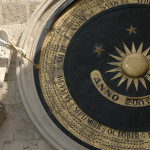
Catania is the second largest Sicilian city after Palermo. It counts about 400.000 inhabitants but considering the suburbs, the figure may reach 800.000 people.
The city lies on the sloped of the volcano Mount Etna. During its history it has been able to adapt itself to several natural disasters that have shaped the architecture of the city. It was razed to the ground seven times by volcanic eruptions and earthquakes. The most recent catastrophic in 1169 and 1693 forced the inhabitants to rebuild the city from scratch.
UNESCO declared Catania Heritage of Humanity in 2002 and now many of its monuments are being restored to bring them back to their original splendour. The origin of the city dates back to 730 b.C. during the first arrival of ancient Greeks and this was the beginning of a long series of invasions and conquests.
Later Normans, Byzantines, Arabs and Spaniards came to conquer these lands, leaving behind footprints that still remain in the collective memory. This allowed the merge of different cultures that now are the distinctive traits of the Catania citizens.
The city was seat of the first Sicilian university, founded in 1434 by Alfonso V of Aragon, and it gives off an intense cultural tradition thanks to cultural clubs promoting academic studies in every area.
The history of Catania
Catania was Greek, Roman, Byzantine, Arab, Norman, Bourbon, Swabian, Angevin, Aragonese, Spanish and obviously Italian city. Therefore, its history is the merge of a great variety of civilizations, who left a deep mark in Sicily.
Catania (the ancient Katane) was founded on the top of a hill by the Greeks in 729 b.C. In 476 b.C. Hieron of Syracuse took possession of the city and repopulated it with a new body of Syracusans colonists. Catania inhabitants resumed power in 461 b.C. However, Catania was conquered again in 263 b.C., when it was declared a Roman colony. By this time it keeps some of its best monuments, like the amphitheatre – whose origin could be Greek -, the theatre, the ruins of the forum, four different thermal baths and the Odeon.
During the early Christian period the myth and devotion to Saint Agatha (Sant’Agata) were born, who was martyrized by Romans, according to the Christian tradition. After the barbarian invasions Byzantium ruled the city and nowadays we keep many tracks of that period.
Later, the Arabs encouraged the development of new agricultural techniques and the rise in exports of crops to Sicily. This turned the city in one of the major economic centre of the island, where the Emir of Catania catalysed his political power.
During the Norman dominations some reforms were made in order to improve cultural activities in the Island, the construction of the cathedral began and lands were given to religious orders.
During the Swabian domination the city was considered an important strategic point and the king Frederick II built the massive Ursino Castle, having the dream to bring the centre of his empire in the heart of the Mediterranean Sea.
During the Aragonese reign, king Alfonso chose to establish in Catania the seat of the first university in Sicily (one of the first universities in Italy), which was a landmark of the culture of the time. So Catania had been the main city of the island, where the King’s seat and the Parliament’s House were located. This situation remained until the move of the royal seat to Palermo, which was the beginning of the economic decline of Catania because of the unproductive management of the Spanish viceroys.
In 1669 the Etna volcano erupted and buried part of the city. In 1693 a massive earthquake disrupted it. From the architectural point of view Catania is a baroque city. After 1693 it was re-planned again by renowned architects led by the great Vaccarini. Thanks to a great fervor of reconstruction he was able to re-born the city in few years, despite the magnificence period will not come back ever.
After the earthquake an important reconstruction campaign started and it continued even after the Italy reunification between 1860 and 1861. Therefore, during XIX century, there was a cultural development of Catania at many levels, above all mundane, literary, musical and off course theatrical. We have to highlight Vincenzo Bellini’s work, one of the favorite city artists, author of the lyric opera Norma and one of the most admired composers in Italy.
Must see in Catania
Visits to do are the Cathedral square, where the Municipality Seat and the Dome are located, near which there is the Elephant fountain (Fontana dell’Elefante) by Vaccarini. We can also mention the fair and the fish market, the Odeon, Via Crociferi – characterized by the presence of many churches -,the Bellini Gardens, the Massimo Theatre named to the native composer Vincenzo Bellini.
You can also see via Etnea with its shops and ice-cream parlor, San Nicolò Church and the monastery of the Benedictines monks (seat of the Faculty of Arts), not forgetting the Ursino Castle and the many baroque palaces of Catania.
Visiting the city may be a good pretext to taste the “pasta alla norma”, a typical dish made of eggplant and ricotta. This local dish take name by the Norma, one of the most famous lyric operas by Vincenzo Bellini.
If you will have the opportunity to visit Catania between February 3rd and 5th, you will take part to the Saint Agatha feast. The saint is the patron of the city and devotion to her is boundless.
Around Catania, up to Messina, you can find the Riviera of the Cyclops (Riviera dei Ciclopi). Here there are attractive towns, such as Aci Castello, famous for its Norman castle lying on a headland of lava rock, and Aci Trezza, with its typical cliffs which Polifemo flung against the boat of the escaping Ulysses, according to the myth.
A little further North is located Acireale, an enchanting town famous for the International Carnival.
The Fontanarossa Airport is located just 8 kilometers far from Catania and it is well connected to the city by frequent bus courses. You can read more info about Catania local transport here.





